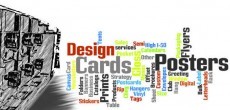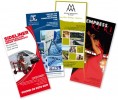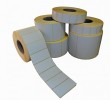« تيار برس » Let us know how we can help you « تيار برس » Business Cards by Tayyar Press « تيار برس » Brochures by Tayyar Press « تيار برس » Flyers by Tayyar Press « تيار برس » Labels by Tayyar Press « تيار برس » Folders by Tayyar Press « تيار برس » Notepads by Tayyar Press « تيار برس » Posters by Tayyar Press « تيار برس » Envelopes by Tayyar Press « تيار برس » Books by Tayyar Press
سؤال وجواب
The Portable Document Format (PDF) is generally the preferred file format for submitting a document for printing as it works with virtually all professional printing and digital output devices. By design, a PDF file incorporates the information needed to maintain document consistency from system to system. Most other file formats such as Adobe InDesign, Illustrator and Microsoft Word are easily converted to PDF format
The technology of design, layout and printing has come a long way to the point where much of the work is done in a WSYWIG (What You See Is What You Get) digital environment. However, there are sometimes noticeable differences in color calibration and spatial conformity from monitor to monitor and consequently from screen to print.
The process for minimizing any variance begins with adjusting your monitor for optimal color and clarity according to the manufacturer's recommendations as outlined within its product manual or website. Doing this will alleviate a number of potential issues.
Beyond that, for the greatest conformity in color from screen to print, there are tools available that will ensure exact color calibration. Perhaps you have already invested in such a tool. If so, let us know what you use and we'll work with you to achieve the best results. If you are considering investing in a color calibration tool, talk to us first and we'll be happy to offer our advice.
A proof is a one-off copy of your printed document used for visual inspection to ensure that the layout and colors of your document are exactly how they are intended to be. A proof is made prior to sending the document to the press for final printing.
Typically, we will produce a proof that will be sent to you online in PDF format or on printed paper, which can be either viewed in our store or delivered to you in person. For multiple-color jobs, we can produce a proof on our output device to show you how the different colors will appear on the final product.
Your approval on the final proof is the best assurance you have that every aspect of our work and your own is correct, and that everything reads and appears the way you intended. Mistakes can and sometimes do happen. It benefits everyone if errors are caught in the proofing process rather than after the job is completed and delivered.
Color separation is the process of separating a colored graphic or photograph into its primary color components in preparation for printed reproduction. For example, to print a full color photo with an offset printing press, we would create four separate printing plates each accounting for one of the four basic printing inks (cyan, magenta, yellow, and black) needed to reproduce the image.
As the paper is fed through the press, each single-color plate puts onto the paper the exact amount of ink needed at exactly the right spot. As the different colored wet inks are applied, they blend together to create the rich and infinite pallet of complex colors needed to reproduce the original image.
Pantone colors refer to the Pantone Matching System (PMS), a color matching system used by the printing industry whereby printing colors are identified by a unique name or number (as opposed to just a visual reference). This helps make sure that colors turn out the same from system to system, and print run to print run
No. White is not generally considered a printing color as typically the paper itself will be white. If a colored paper (something other than white) is chosen, then white becomes a printing color if any text or graphics require it.






